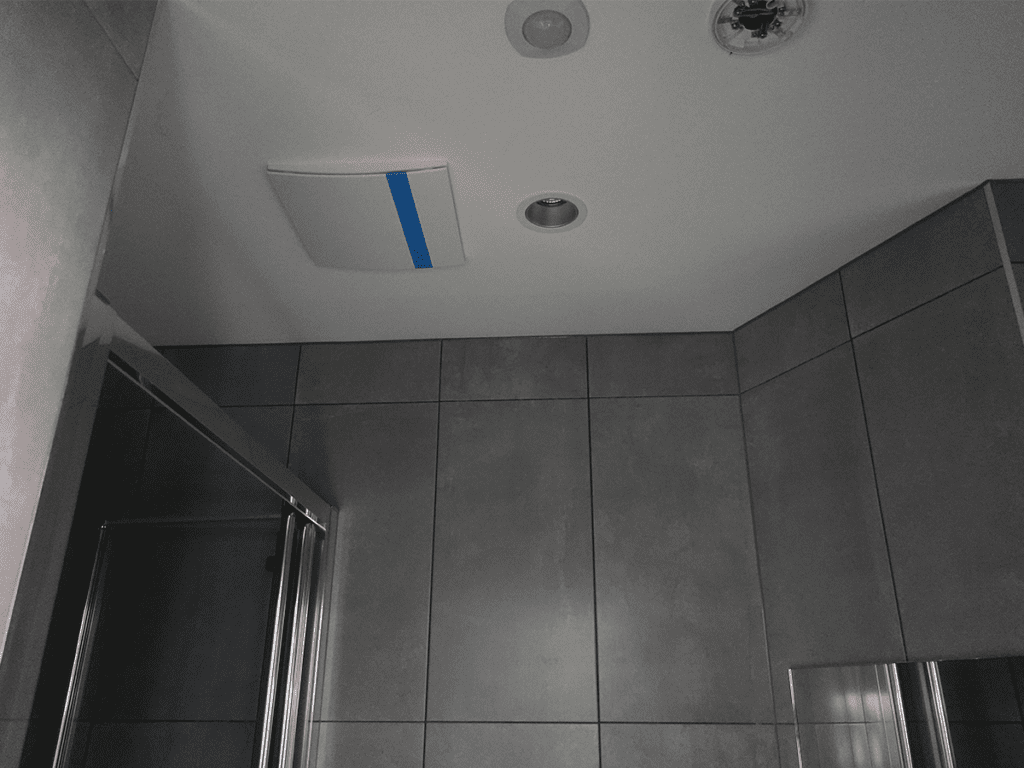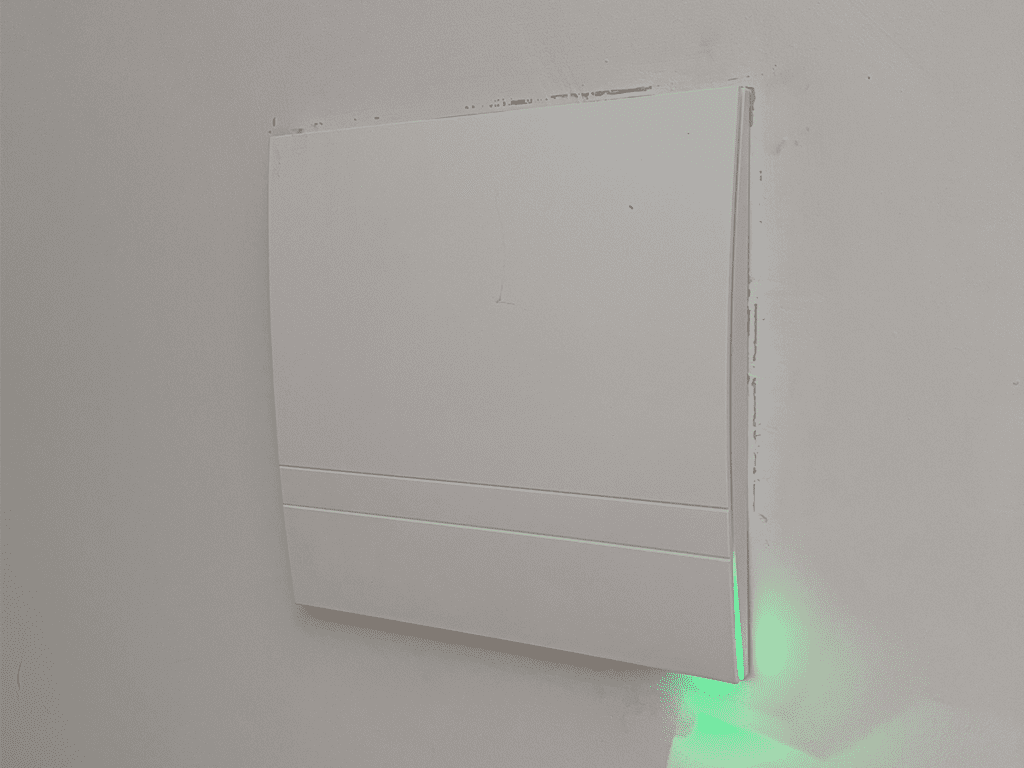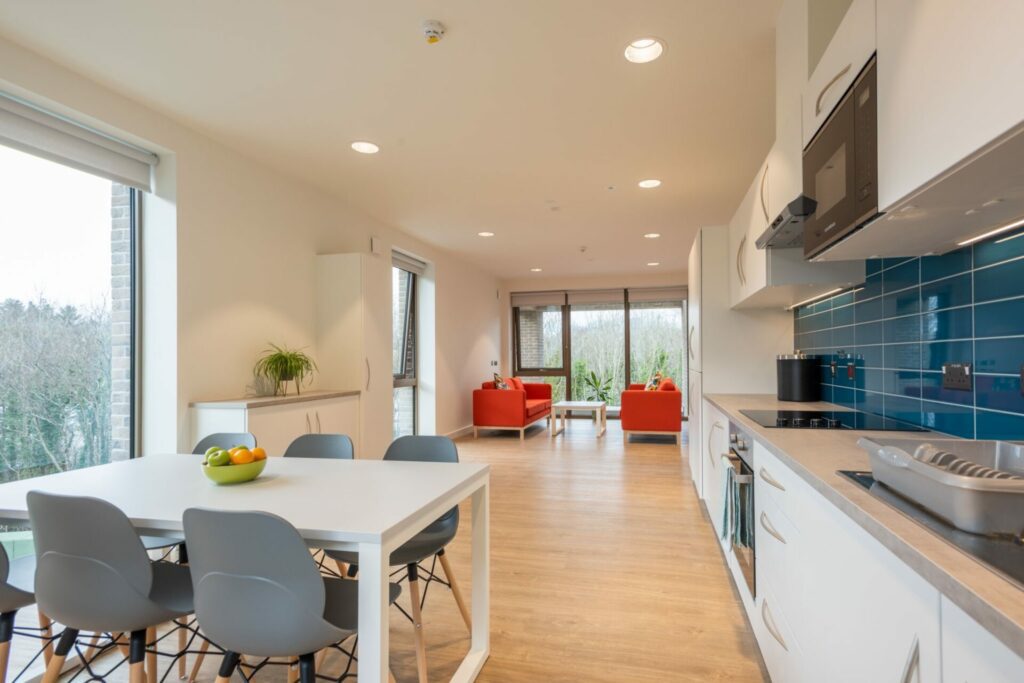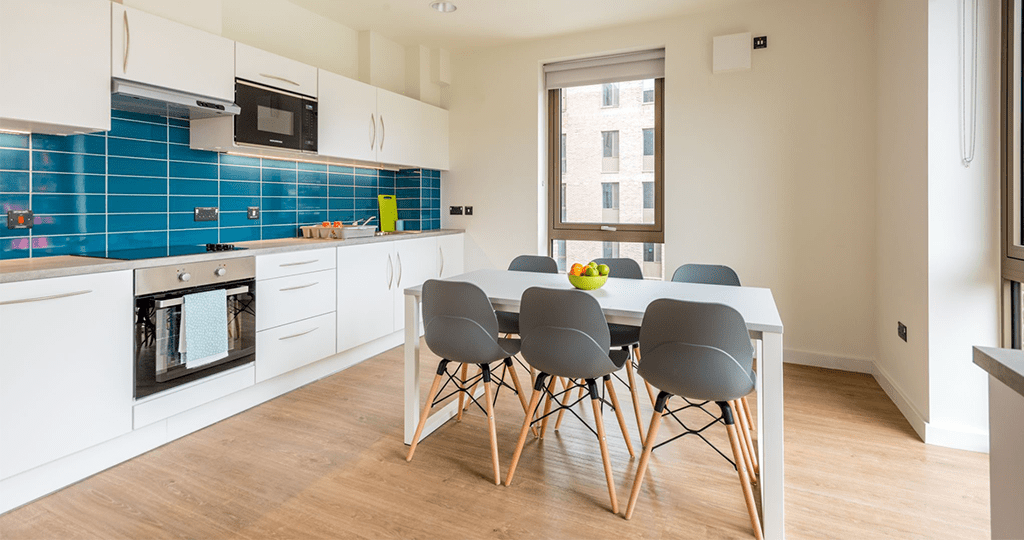Project Overview
The University of Galway embarked on a student accommodation project with the primary objective of providing comfortable and healthy indoor air quality throughout the accommodation buildings. To achieve this goal, the project incorporated innovative ventilation solutions, specifically focusing on bedrooms, ensuites, kitchens, accessible W/Cs, and building cleaning sluice rooms. The University of Galway student accommodation project prioritized indoor air quality by implementing an advanced Continuous Mechanical Extract Ventilation (CMEV) system.
Ventilation Units Used
For this project, Partel’s CMEV (Continuous Mechanical Extract Ventilation) system was selected to ensure efficient and decentralized ventilation. The specific units employed were the Silvento V-EC FK extract fans and the ALD-R 160 passive intake units.
Ventilation System Components:
- Lunos Silvento V-EC FK Extract Fans:
The Silvento V-EC FK extract fans were strategically installed in ensuites and kitchen areas. These units serve as the primary extraction source, continuously maintaining background ventilation rates to meet Part F regulations.
Each Silvento FK unit is equipped with an energy-efficient EC (Electronically Commutated) motor, ensuring energy savings and longevity.
The control boards on Silvento FK units play a pivotal role in automatically adjusting the extraction rate based on real-time air quality parameters.


- Lunos ALD-R 160 Passive Intake Units:
To balance the ventilation system, ALD-R 160 passive intake units were deployed. These units provide a constant flow of fresh and filtered outdoor air into the accommodation spaces.
They are designed with sound and wind protection features, ensuring a comfortable passive intake of outdoor air while minimizing noise and drafts.
Advanced Control Mechanism:
The heart of the CMEV system lies in its advanced control mechanism, which optimizes ventilation based on real-time air quality data.
Sensors integrated into the Silvento FK units continuously monitor levels of Carbon Dioxide (CO2), Volatile Organic Compounds (VOCs), and humidity. These sensors provide precise data on indoor air quality.
When air quality deteriorates due to increased CO2 levels or the presence of VOCs, the control board responds by automatically boosting the extraction rate to its maximum level. This proactive adjustment ensures that the indoor environment remains comfortable and healthy.
Benefits of CMEV System:
Energy Efficiency: The utilization of EC motors in Silvento FK units reduces energy consumption, contributing to the project’s sustainability goals.
Occupant Comfort: The decentralized ventilation approach and automatic boosting of extraction rates guarantee consistent and comfortable indoor conditions for occupants.
Ease of Maintenance: Washable filters located on the room side of the units simplify maintenance. Regular filter cleaning ensures an uninterrupted flow of fresh air.
Compliance with Regulations: The CMEV system meets and exceeds Part F regulations, delivering a highly efficient ventilation solution that aligns with industry standards.
The Challenge
The project faced several challenges related to providing optimal indoor air quality in a student accommodation setting. These challenges included:
Comfortable air quality:
It was crucial to ensure that the air quality in bedrooms, ensuites, kitchens, accessible W/Cs, and cleaning sluice rooms met or exceeded the required standards for health and comfort, while also maintaining occupant comfort during construction

Coordinating Construction and Ventilation Installation:
The project involved not only the construction of student accommodation facilities but also the installation of a sophisticated Continuous Mechanical Extract Ventilation (CMEV) system. Coordinating these parallel efforts was challenging to ensure that construction did not impede the installation and functionality of the ventilation system.
One of the other primary challenges was ensuring that students returning to the accommodation would experience minimal disruption and discomfort during ongoing construction and ventilation system installations. The need to balance construction activities with students’ daily routines and academic schedules required meticulous planning and coordination.
Occupant Safety and Health During Works:
The safety and health of students returning to accommodation were paramount during construction and ventilation system works.
Dust, noise, and potential disruptions due to construction posed risks that needed to be managed effectively to prevent accidents or health issues.
Meeting Project Deadlines:
The project had set deadlines to accommodate students returning for the academic year.
Timely completion of construction and ventilation works was crucial to avoid any delays that might inconvenience students and affect the academic calendar.
Effective Communication with Occupants:
Communicating construction schedules, potential disruptions, and safety precautions to students returning to the accommodation was essential to manage expectations and minimize inconveniences.
The Solution
To address these challenges, the project adopted several strategies:
Phased Construction:
Construction was divided into phases to minimize disruption. Areas where students were already accommodated were prioritized for ventilation system installation, allowing students to return to upgraded rooms.
Strict Safety Protocols:
Rigorous safety protocols were enforced to protect students and workers during construction. This included dust control measures, noise restrictions during study hours, and clear signage indicating construction zones.
Regular Communication:
Effective communication channels were established to keep students informed about construction schedules, potential disruptions, and safety measures. Feedback mechanisms were put in place to address any concerns or issues promptly.
Flexible Construction Hours:
In areas with student occupancy, construction work hours were adjusted to minimize disturbances during study and sleep times.
Accelerated Ventilation Installation:
To meet project deadlines, the installation of the CMEV system was expedited, with close collaboration between construction teams and ventilation system installers.
Silvento FK Units: In ensuites and kitchen areas, Silvento FK units were installed. These units were set to run continuously at the designed background ventilation rate to comply with Part F regulations. They function as a low-level, constant source of ventilation.

Automatic Boosting: The Silvento FK units were equipped with control boards featuring sensors that continuously measured levels of CO2, volatile organic compounds (VOCs), and humidity. When poor air quality was detected, the units automatically boosted the extraction rate to maximum levels. This removed the need for manual user input to increase ventilation.
ALD-R 160 Units: The ALD-R 160 units were integrated to provide passive intake of fresh, filtered air. These units not only ensured a constant flow of fresh air but also included sound and wind protection features to enhance occupant comfort.
Benefits
The approach taken to address these challenges resulted in several benefits:
Minimal Disruption: Students experienced minimal disruption during their return to accommodation due to the phased construction approach and clear communication of construction schedules.
Enhanced Safety: Stringent safety protocols ensured the safety and well-being of both students and workers during construction activities.
Timely Completion: The project met its deadlines, allowing students to occupy upgraded rooms and commence the academic year as planned.
Positive Engagement: Effective communication and feedback mechanisms fostered a positive relationship between students, project organizers, and construction teams.
By considering the challenges associated with students returning to accommodation while works were ongoing, the project demonstrated its commitment to occupant comfort, safety, and satisfaction, ultimately contributing to the project’s success.
The utilization of Partel’s CMEV system brought several benefits to the student accommodation project:
Ease of Installation: Units were installed on external walls, minimizing the need for extensive ducting within the building, simplifying installation.
Maintenance: All units featured easily accessible washable filters on the room side, facilitating straightforward maintenance and ensuring a continuous flow of healthy air.
Automatic Boosting: The intelligent control boards allowed for automatic boosting of the extract fan in response to air quality, eliminating the need for manual intervention and enhancing indoor air quality.
Partel Services Provided
Partel played a crucial role in the success of the project:
Design and Layout: Partel provided expert guidance in designing and laying out the ventilation system to ensure strict compliance with Part F regulations.
Technical Support: Extensive technical support was offered to the on-site contractor responsible for the installation of the Lunos system. This support included guidance on placement, wiring, and control board configuration.
Commissioning: During the second fix phase, Partel conducted commissioning of the Silvento and ALD units. This involved ensuring correct installation and flow rates to meet Part F requirements.
Maintenance and Service: To maintain a positive and enduring partnership with the University of Galway, Partel offered ongoing maintenance and service support. This ensures the continued functionality and efficiency of the ventilation system.
In conclusion, the University of Galway student accommodation project exemplifies a successful integration of advanced CMEV technology to address indoor air quality challenges in various spaces. The technical details of the Silvento FK units, ALD-R 160 units, and the intelligent control mechanism demonstrate how innovative ventilation solutions can achieve comfort, health, and compliance in residential environments.





